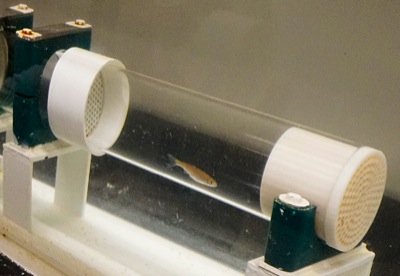Wednesday, July 6th, 2016
Campus snags fish study grant
Professor says minnows crucial to the ecology of rivers, streams
By Claire Giesige

Photo by Claire Giesige/The Daily Standard
Dr. Stephen Jacquemin, from left, Cara Schemmel and Stephen Huelsman monitor the performance of a fish swimming in an endurance chamber. The chamber was created in partnership with Wright State University-Lake Campus engineers specifically for a research project headed by Jacquemin that tests the swimming performance of six species of fish from the Cyprinidae and Percidae families.
CELINA - A Wright State University-Lake Campus research team is conducting a unique study on often-overlooked fish thanks to a grant.
Under the direction of Dr. Stephen Jacquemin, assistant biology professor, the research project assesses the swimming performance of small-bodied fish in the Cyprinidae and Percidae families - commonly known as minnows and darters.
"This project is all about assessing what types of these small fish we find around here and moreover how well they can swim in rivers and streams," Jacquemin said.
The key to preserving our resources is understanding them, Jacquemin said.
"Our rivers and streams have been altered on a global basis," he said. "Many of them don't behave like rivers and streams anymore because we've altered the flow so much. ... We've changed, fundamentally, our rivers and streams, which means we've changed the flow. And what does that mean? That's what we're doing."
Jacquemin explained the "classically underappreciated" minnows and darters are crucial to the ecology of rivers and streams and if they leave or get washed out, the whole ecosystem suffers.
"It's under the surface of the water and they're so small, most people equate them to, 'oh, it's just a minnow.' But the fact is we have hundreds of species in both of these groups that are traditionally overlooked," he said. "But conservation of any aquatic resource has got to start from the ground up, and these guys represent that ground. ... These guys are sort of the linchpin of holding the health together."
Although small, minnows and darters make up a large portion of the aquatic creatures in the area.
"When you look at the actual mass, if you took every living thing out of the stream and you laid it all out, these minnows and darters would comprise the greatest percentage of the biomass," Jacquemin said. "It's not going to be that 5-pound bass. Even though that thing's huge, it's got nothing on 4,000 bluntnose minnows. And so the importance of these guys can't be overstated."
Redfin shiners, bluntnose minnows, spotfin shiners, sand shiners, greenside darters and Johnny darters have been collected from the Blanchard River, Auglaize River, St. Marys River and Grand Lake. Jacquemin and three undergraduates are testing the species' swimming performance to see at which speeds they can swim. Much like a human running, they are limited in how long and fast they can go.
Knowing the limits is important, especially when it comes to modifying bodies of water.
"The implication of that is, if you can establish how well or how effective of swimmers these different species are, you can use that to make actual management and conservation decisions out in the stream," he said. "There are such things as hard barriers, like a dam. Very few things are going to go over that. But what if it's not a dam? It could be a very fast shoot of water. It's water, you may think it can't be a barrier, but the reality is, if the speed is such that they can't make it, you might have created a barrier without realizing it."
Jacquemin's team is studying anything that changes the natural flow of a river or stream that might affect the species. If a barrier is created, it has a consequence upstream.
"(The fish) are all so different. They all have little differences in diet, little differences in habitat that they prefer. But regardless of their differences, they are similar in that they all represent the base of the ecosystem, the health of which, all these streams and rivers and lakes, really rests on this base," Jacquemin said. "It's like building a pyramid. You can't have the nice top without having those perfectly spaced blocks on the bottom."
The team is using a tank that was designed and built at the regional campus in collaboration with Lake Campus engineers. Six days a week, fish are put one at a time into a tube that has an adjustable flow of water. They are acclimated to a gentle flow, which is then turned up in timed increments until they "wash out" to the back of the tank - a process that does not harm the fish - and the researchers note their ultimate speed and time.
The information could someday be used in the design process for things such as new bridges or road crossings. With the data being collected, engineers could factor in how fast the water should move in relation to minnows' and darters' swimming abilities.
The sample fish may have been collected locally, but the data will be applicable to the entire Great Lakes region. The species were chosen because they apppear across the region.
The team is looking at variables that may affect swimming performance, including size, sex and species.
"What we're finding is, from the preliminary data that's coming out of this chamber, it tells us that everything matters," Jacquemin said.
As an example, he explained that males tend to be faster than females.
"So you might have it where only the males can cross," he said, which creates obvious problems for the species' survival in an area.
The project has been in the works for two years but funding from the Ohio Sea Grant got the ball rolling about a month ago.
"They are supporting one-of-a-kind, unique research right here at Lake Campus. No one else is doing this," Jacquemin said.
While other people are also researching the subject, he said it's an understudied topic overall.
"I think the reason for that is there's not a huge push in terms of grant funding and research. The reality is, most of our conservation money comes from the gamefish," he said. "It comes from an offshoot of maybe fishing license and hunting license sales, so the demand is going to be for things that you can directly catch."
He added the project gives Lake Campus undergraduate students Stephen Huelsman, Cara Schemmel and Austin Smith a unique experience. They will be able to publish in scientific journals and present their results at Ohio Academy of Science and Midwest Fish and Wildlife conferences.
"This is a good experience for me, building a research background, because I want to go to graduate school," Huelsman said.
Jacquemin said he's extremely happy the Ohio Sea Grant funded the project.
"It's been fantastic. It's been a long road to get to this point. It's amazing to see all the data start pouring in, and it will be an even better feeling when things are finalized," he said.

Photo by Claire Giesige/The Daily Standard
This specially designed tank tests swimming performance using a tube that has an adjustable water flow. The flow is gradually increased until the fish can no longer keep up and gets washed out.


